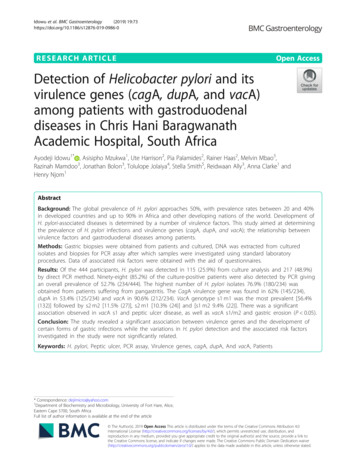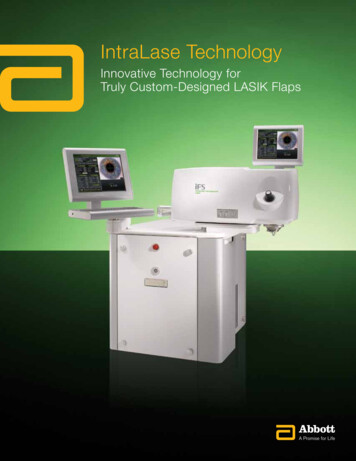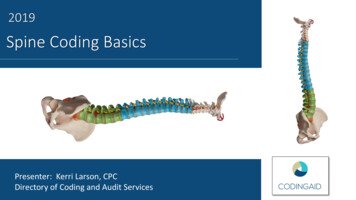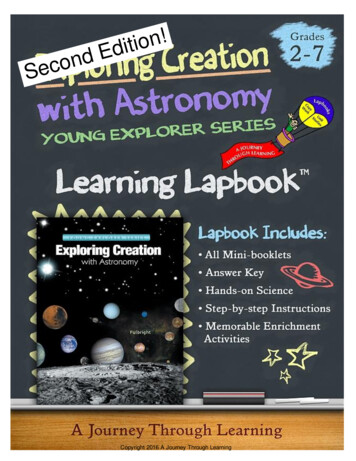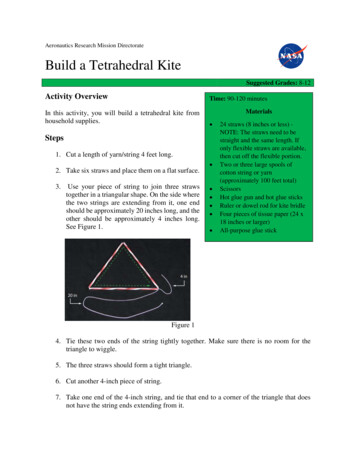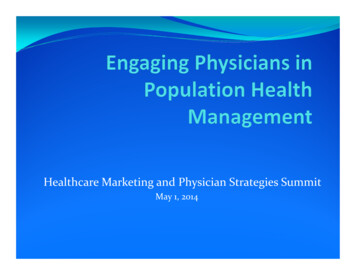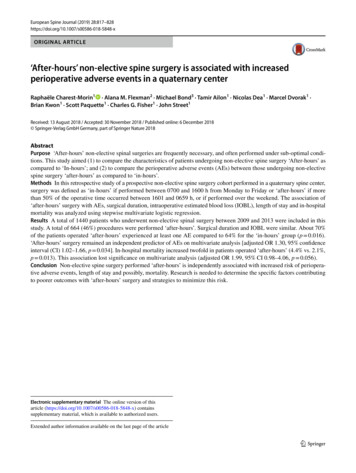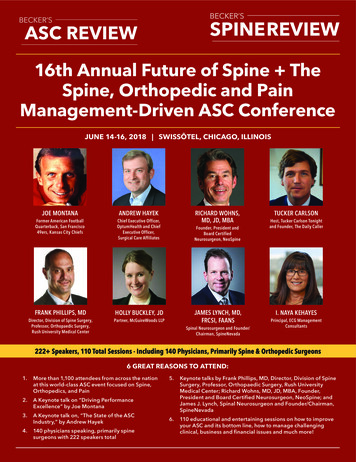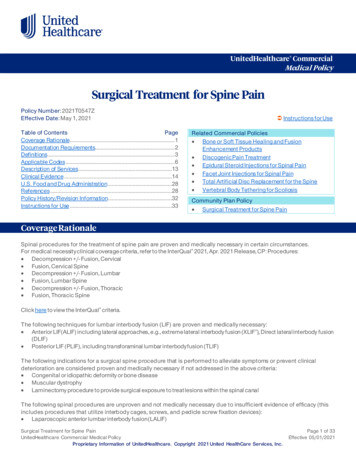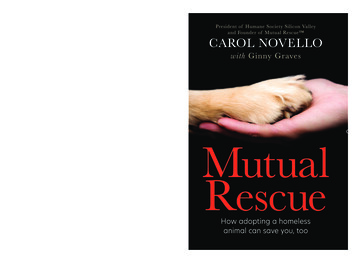
Transcription
153 234 SPINE: 20MUTUAL RESCUE is a collection of these real accounts from peoplewhose lives have been forever altered by giving a home to an animal inneed. Novello explores one aspect of pet adoption and the many waysit expands and enriches people’s lives. The beautifully complex rolesthat pets play when they become part of our families.You’ll meet people whose rescued animals gave them the strengthto face trauma and grief. Ultimately you will learn of pets that havehelped individuals cope and recover from physical illnesses, injuries,or obesity; and you’ll see how rescued pets offer hope to those afflictedwith depression, loneliness, and post-traumatic stress disorder. Helpingpeople live with more meaning and compassion, rescued pets can oftenbe a profound source of healing.This illuminating look into the potential of pets to shape our livesand open our hearts will transform the way you think about homelessanimals and their place in the world.Scan here tomeet the authorRRP 29.99Non-fictionwww.booktopia.com.auMutual RescueAnyone who has an adopted dog or cat knows the delight and comfortpets bring to everyday life, and in many cases, can be transformative.When Carol Novello began working at Humane Society Silicon Valley,she discovered evidence of the life-changing impact homeless animalshave on people—how they could lift moods, enhance physical wellbeing, and improve people’s ability to communicate and connect.How adopting a homeless animal can save you, tooA MOVING AND SCIENTIFIC LOOKAT THE THERAPEUTIC POWER OFRESCUING A HOMELESS ANIMAL.FLAPS: 0MutualRescueHow adopting a homelessanimal can save you, too
“Adopting a pet can greatly benefit the lives ofpeople who are emotionally hurting. Read theseheart-warming stories in Mutual Rescue.”—TEMPLE GRANDIN, PhD, author of Animalsin Translation and Animals Make Us Human“Through authentic accounts, scientific evidence,and personal narrative, Carol Novello illustrates how whenwe rescue a homeless animal, we ourselves are so oftenrescued right back! This book is destined to save lives.”—MARTY BECKER, DVM, and JACK CANFIELD,#1 New York Times bestselling co-authors ofChicken Soup for the Pet Lover’s Soul“Packed with heartrending stories of strugglingpeople who have adopted homeless animals, this fascinatingbook reveals the many unrecognized ways dogs and catscan ground us, provide a sense of purpose, and give usthe strength to move forward. Part science, part story,Mutual Rescue is all heart. It made me cryand filled me with hope for our planetand every person on it.”—MALLIKA CHOPRA, author of Living with Intent:My Somewhat Messy Journey to Purpose, Peace, and Joy“I love Mutual Rescue’s films, so when I heardabout this new book, I raced to read it. The storiesabout rescued pets rescuing people were like rays of brightsunshine on a stormy afternoon. Truly an awe-inspiring book!”—MARCI SHIMOFF, #1 New York Timesbestselling author of Happy for No Reasonand Chicken Soup for the Woman’s Soul“Mutual Rescue juxtaposes authentic storiesand scientific thought about the animal-human bond.It touches hearts, opens minds, and inspirescompassion—a life-changing book.”—BRIAN HARE, founder of Duke CanineCognition Center and New York Times bestsellingauthor of The Genius of DogsCAROL AND HER DOGCAROL NOVELLO holds a HarvardMBA and was a senior executive workingin the tech sector most recently at Intuit,Inc. Today, she is president of HumaneSociety Silicon Valley and has beenawarded the Maddie’s Fund “MaddieHero Award” for innovation andleadership in animal welfare. She alsolaunched Mutual Rescue, a campaignof short films designed to showcasethe therapeutic benefits of animalcompanionship and encourage adoptions.These films have been viewed millionsof times across various social mediaplatforms around the globe.Carol lives in the San Francisco BayArea, where she enjoys spending timewith her own adopted companions:Tess, a German shepherd, and tuxedocats, Bode and Herbie.
MutualRescueHow Adopting aHomeless AnimalCan Save You, TooCarol Novellowith Ginny Graves
ContentsIntroduction 1SECTION IHEARTCHAPTER 1 FINDING COURAGEPets as Secure Bases and Safe Havens 13CHAPTER 2 BUILDING TRUSTAnimals and the Biochemistry of Bonding 30CHAPTER 3 COPING WITH GRIEFFur as a Source of Comfort and Solace 45CHAPTER 4 FLOURISHING AFTER SORROW Four- L egged Support for Post- Traumatic Growth 59SECTION IIBODYCHAPTER 5 VITALIZING PHYSICAL HEALTHThe Effect of Wags and Whiskers on Physiology 77CHAPTER 6 EMBRACING JOYAnimals’ Playful Companionship Transforms Loneliness 92CHAPTER 7 OVERCOMING ILLNESS AND INJURYThe Role of Pets in Persevering Through Physical Challenges 107
viii ContentsCHAPTER 8 RECOVERING FROM ADDICTIONThe Stabilizing Power of Furry Acceptance 124SECTION IIIMINDCHAPTER 9 CULTIVATING GRITPets as a Source of Strength and Resilience 141CHAPTER 10 SUPPORTING MENTAL ANDEMOTIONAL W ELL- BEINGPaws Anchor Us in the Present 157CHAPTER 11 FOSTERING CHILDREN’S DEVELOPMENTAnimals’ Impact on Autism, Reading Skills, and Cognitive Growth 174SECTION IVCONNECTIONCHAPTER 12 ENRICHING RELATIONSHIPSPets Bind Us Together 193CHAPTER 13 BEYOND CATS AND DOGSAppreciating the Natural World and All the Creatures in It 210CHAPTER 14 DISCOVERING PURPOSEWhat Animals Can Teach Us About Meaning, Love, and Faith 224About Mutual Rescue 239Shelters and Rescue Organizations Referenced in the Book 241AcknowledgmentsSources243249About the Author and Collaborator 263
IntroductionFrom my office at Humane Society Silicon Valley, I look out ona small plot of land dotted with bushes that we call the Community Cat Garden. Inside the fenced space, undomesticated cats, orCarol’s Ferals, as my co‑workers call them, live until we can find safehomes for them in a barn or garden nursery. These creatures tendto hole up in their condos, like Floridian retirees, emerging predictably at dusk, when their dark profiles are hard to distinguish fromthe lengthening shadows. My German shepherd rescue, Tess, and Ioften stare out the window, both hoping to catch a glimpse of oneof these reclusive creatures that exist in the netherworld between theaverage coddled housecat and their large, predatory ancestors whoare sometimes sighted in the nearby California hills. The untamedcats’ G arbo- esque nature (they “vant to be left alone”) is fascinatingpartly because it stands in stark contrast to most of the pets I’ve hadover the years, who craved my company and care. But they bring tomind another feline from my long- ago past, whose appearance wasformative and set the stage for some of the most meaningful decisions I’ve ever made.It was the holidays, and my parents and I were shopping at aChristmas tree farm near our home in the Philadelphia suburbs. Iwas five. The frigid air, alive with the scent of spruce and the tinglyanticipation of the season, heightened my sense of purpose: I wouldfind our family the perfect tree. I was eyeing a promising specimenwhen a slinky shape emerged from beneath its branches. A cat! Hewalked up to me, and when I knelt down to pet him, his pale amber
2 Introductionfur felt like flimsy protection from the cold. He head- butted myknee and began to purr. “Why is he here?” I asked my mom, alreadysmitten. “Do you think he has a home? If he’s on his own, can wekeep him? Please?”“I’ll find out,” she said. As I watched her walk away to talk tothe farm’s owner, my heart was caught in a tug‑of‑war betweenhope and disappointment. Based on my five years of experience, thelatter appeared far more likely. In our family constellation, my dadand I rotated easily in the same orbit, but my mother always seemedmore remote and unreachable. I understood that she loved me in herown way, but it didn’t feel the same as it did with my father, whosecompanionship was like a cozy fire. Warm. Welcoming. Safe. Andthat’s one reason this moment remains firmly rooted in my memory.When my mom returned, she was smiling. “Someone dumped thecat here, so we can keep him,” she announced. I was thrilled— anddumbstruck. My mother had said yes. More than that, she felt thesame tenderness toward this stray that I did. Animals were the crackin her shield that allowed a glimmer of love to break through— aspace that enabled her to feel and express love. And, now, miraculously, here she was, after we chose a tree, saying, “Well, come on,Carol, let’s get the cat in the car before he freezes to death.” For thefirst time in my young life, I sensed that we might be able to connect. Animals might bridge the divide.Together, we went to the supermarket and bought our new family member a flounder, which we g ift- wrapped and placed under thetree on Christmas morning. All three of us laughed as we watchedNicholas Quattromano (named after St. Nicholas and “four hands”in Italian, a nod to my father’s heritage) sniff out his present andshred the paper to u ncover— and d evour— the fish. Not surprisingly,his rescue ignited my passion for adopting homeless creatures. Rescuing Nick, as we called him, created a way for my mom and me toshare the same world. It didn’t fix our relationship. But it allowedme to glimpse her softer, more k ind hearted side and revealed thatwe shared something in common.
Introduction 3Even though Nick’s initial tentative friendliness turned out tobe a calculated gambit to get us to bring him in from the cold— thereafter, he spent the majority of his time atop the refrigerator,safely out of reach of my grasping, cuddling arms— I felt happy thathe had a safe home, that he was ours, and that he could dependon us. The seed of my passion for rescuing homeless animals wasplanted.Nick was the first of many strays we welcomed into our homeover the coming years. His rescue laid the initial stone in my meandering path that led from Harvard Business School to a decade with high- tech software producer I ntuit— which set off a search for greatermeaning and eventually steered me toward the work I do today aspresident of our bustling shelter in the heart of Silicon Valley.Given my lifelong love of animals, accepting the job at HumaneSociety Silicon Valley was, in my mind, a fait accompli. But not everyone saw it that way. Some former colleagues and casual acquaintances, as well as people I met as I began raising money for theorganization, didn’t understand why someone who had an MBAfrom Harvard and had run multi- million- dollar businesses for Intuitwould veer into animal welfare; others could relate to the impulseto do something philanthropic but didn’t get why I wasn’t tryingto alleviate human suffering. Ultimately, they all asked similar versions of the same question: “Why are you helping animals when youcould be helping people?”In response, I’d quote the statistics that spurred my passion foranimal welfare: While great strides have been made in saving animals’ lives in the United States, more than 6.5 million cats and dogsstill enter animal shelters each y ear— and 1.5 million are euthanized.And of the roughly 410 billion that Americans give to charities,only 3 percent goes to animal- related and environmental causescombined. People nodded their heads, and many expressed genuineconcern, but I could tell that most weren’t fully persuaded. I beganto sense that those heartbreaking statistics were only part of the story— that I was missing a deeper truth.
4 IntroductionAs I groped for a fuller explanation, I started thinking about mymother and how Nick had been the saving grace of our relationship.The tenderness I saw her express toward the creatures that populated our lives showed me she was capable of love, even if she wasn’talways able to express it to me in the way I longed for. I still felt saddened by our relationship, but somewhere along the way I realizedI could either be resentful and angry for what she didn’t give me orgrateful for what she did: a devotion to animals that led to my life’spurpose. I chose the latter. As I thought more about what animalshave meant in my life— how they’ve given me hope when I wasdespondent, laughter when I was stressed, companionship when Iwas lonely— as well as the lives of nearly every pet owner I know, Ifinally saw it— the hidden “why” of animal rescue: By helping animals I am helping people— helping them heal their own pain, findgreater purpose, and discover more sources of joy.The human race is definitely in need of help. The magnitudeof misery, even in our prosperous country, is m ind- boggling. Sixteen million adults in the United States struggle with depression.About 8 million adults in any given year have p ost- traumatic stressdisorder. Twenty- nine million are diagnosed with diabetes, and anestimated 8 million have it but don’t yet know it. Meanwhile, nearly40 percent of people are obese. And that’s not counting the grieving,heartbroken, sedentary masses who may not be diagnosable but arestruggling and hurting nonetheless. But there’s hope for a healthierfuture, and what leads us toward it may very well have four legs anda tail. Companion animals can help relieve a range of t roubles— and as I and my writing collaborator, Ginny Graves, explain in thechapters ahead, there’s scientific research that proves it. The dataaffirming animals’ positive effects on human health is so persuasivethat 60 percent of doctors in a recent survey said they prescribe petadoption, and a staggering 97 percent believe pet ownership provides health benefits. While this research is applicable to animals in general— regardless of whether they were rescued or n ot— givinga shelter animal a home confers a special kind of restorative grace.
Introduction 5Naturally, I’m biased toward encouraging people to adopt shelterpets. But I believe that showing benevolence for a homeless creaturefertilizes the seeds of kindness, generosity, and compassion that existinside us, spurring those qualities to put down roots and thrive. Itgrounds us in love.People facing serious challenges often benefit profoundly fromadopting an animal, but pets can enrich anyone’s busy life. They alsocome with their share of demands and headaches, of course, as anyone who has stepped in warm dog barf at four a.m. can testify. Butcaring for another creature, and having someone who depends onyou, can be its own kind of blessing, adding dimension and meaningto the daily routine. And beyond the hassles, most people who adoptan animal find so much reward.Cats and dogs inject contentment, warmth, and goofy littlehits of delight into our days that distract us from our worries, keepus grounded in the here and now, and remind us what m atters— including the fact that a grubby tennis ball or ratty ball of yarn canbe a source of real joy. My cat, Wilbur, a master prankster whom Iadopted when I was thirty, revealed the wonder of kitchen drawers. He would pull out a bottom drawer, crawl behind it, claw hisway up the rear of the cabinet, and emerge out the top drawer, likeHoudini popping to the surface after being shackled in an under water crate. Wilbur would look at me like, “Ta‑da! Pretty cool, huh?” Itnever failed to make me laugh— and ease the stress of work. Wilburwas an antidepressant and anxiety cure in a single furry package.In studies with a variety of types of people, the same storyemerges. Interacting with an animal can lift mood, increase well- being, and facilitate the ability to communicate and connect. Giventhe rampant ill health, emotional and physical, in our culture, that’sactually a profoundly hopeful, and radically important, finding.After accepting my role at Humane Society Silicon Valley, I beganfinding evidence of the life- changing impact of pets everywhere,and the more stories I heard about people who’d regained theirvitality and flourished after adopting a cat or dog, the more urgently
6 IntroductionI felt the need to share them. People needed to know that rescuingan animal doesn’t mean ignoring humanity’s woes; it’s a vital partof the solution!In 2015, a board member introduced me to David Whitman, astoryteller and creative producer, who helped me come up with away to spread the word about the transformative power of adoptingan animal. He coined the phrase “mutual rescue” and suggested wemake short films of people whose lives have been dramatically bettered by rescuing an animal. As it happened, I had the perfect candidate already in mind. About a year before, we had received a letterfrom an obese man who told us he’d become vastly healthier afteradopting an overweight dog from our shelter. We made his journeythe subject of our first film, hoping it would reach enough peopleto inspire others across the country to submit their own stories forconsideration and encourage people to adopt shelter animals. Wehad no idea what we were in for. Eric & Peety, that first short film,caught fire and has now been viewed more than 100 million timesin more than forty countries.We were flooded with story submissions from people who’d beendepressed, suicidal, diabetic, broken, homeless, lonely, and more— a ll of whom had moving, uplifting stories about how their rescuepets had saved them. We turned four of their redemptive stories intoshort fi lms— and watched this international phenomenon flourish.Kylie & Liza, our second film, released in early 2017, tells the story ofan effervescent t welve- year- old girl battling lethal bone cancer andthe kitten she adopts, who, after her death, became a vital sourceof solace for her grieving mom. We released three more films laterthat year, and collectively those four films have garnered more than35 million views to date.The films struck a chord because they depict the essence of mutualrescue. But as we dug deeper into our trove of anecdotes, I realizedthe full story of what happens when a human adopts an animal can’tbe told in a fi ve- minute film. One of the truly astonishing aspects ofthis phenomenon is that the uplifting effect often spreads beyond the
Introduction 7person who adopts a stray. Take my experience with Wilbur and hisfeline brother, Wiley, who was a total love bug with his own sweetcharisma. By buoying me up and bolstering my resilience, thosetwo helped me be a more genial and compassionate leader at work,which created a collaborative environment that allowed my team tofeel more empowered and function more effectively. In other words,two goof ball cats helped set off a mini upward spiral of positiveenergy. And that’s just one small example of something that happensroutinely when a person rescues an animal: The meaningful bondhumans often form with their pets can foster a deep sense of well- being that allows them to embrace life and love more fully, and theymay inspire others to do the same.A Harvard study tracking the lives of 238 men since 1938 hasfound that close relationships, more than money or success, are whatmake us happy. George Vaillant, who led the study from 1972 to2004, wrote that there are two pillars of this deep and enduring happiness: “One is love,” he says. “The other is finding a way of copingwith life that does not push love away.” Rescue animals are a copingmechanism that draws love in— increasing the odds that we can radiate love out. And when one person becomes more upbeat, the feeling can spread to others, according to a separate group of Harvardresearchers. Their fascinating studies revealed that having a happyfriend who lives within a mile increases the probability that youwill be happy, too— and that bliss often spreads to neighbors, nearbysiblings, and spouses. In other words, the joy one person generatesfrom adopting an animal can be contagious.I’ve come to think of this phenomenon as the “rescue effect,”because adopting an animal can create ripples of w ell- being thatimpact concentric circles of p eople— sometimes even total strangers. The idea was inspired by “the butterfly effect,” a scientific phenomenon that shows, in essence, that the flap of a butterfly’s wingsin Australia can set enough molecules of air in motion to create atornado in Kansas. Put simply: Small changes can have surprisinglylarge consequences.
8 IntroductionIn the following chapters, we reveal the countless ways this playsout in real people’s lives. We start with the Heart section, whereyou’ll meet people whose rescue animals have helped them faceinconceivable trauma and grief and provided the strength, courage,and wisdom they needed to find their way forward. In the Body section, we share stories of people who’ve learned that adopting a cator dog can not only help them become healthier but also help themcope with and recover from physical illnesses and injuries and showthem how to thrive in spite of their d isabilities— and experiencemore joy. In Mind, you’ll see how rescue animals can actually savepeople coping with anxiety, depression, and post- traumatic stressdisorder (PTSD), offering them hope, helping them create healthierpatterns of thought, and leading them toward lives filled with meaning and compassion. But nearly every story has all three e lements— heart, mind, and body— a graphic demonstration of the expansiveand multifaceted impact of rescuing an animal. And people in thesenarratives aren’t the only ones who benefit; the animals do, too, inways that are surprising, tender, and sometimes profound.Finally, in Connection, we reveal how pets can strengthen ourrelationships with the people we love, how we can bond deeply withmany types of animals, not just cats and dogs, and how, when rescuepets make people healthier and happier, something remarkable canhappen: Their hearts mended, these humans often go on to makepositive contributions to the world and pay forward the love andhealing they received. Some find a deeper sense of purpose, othersdevelop a stronger understanding of who they are and why they’rehere, and some even discover a renewed sense of their own personalfaith or relationship with something divine, however they define it.The stories and research in this book reveal what I know to betrue: Rescue pets can help us evolve as people, because they give usa safe way to practice opening our hearts, and once we learn how tobe more open and empathetic with pets, we can become more compassionate with ourselves, better at being tender with others— andmore inspired to contribute to humanity.
Introduction 9Animals can bring us face‑to‑face with both our flaws and ourdeeper potential. They can train us to be more reliable and responsible. They can help us overcome our shortcomings and set us on theroad to becoming our best selves— loving, nurturing, caring, giving.And by presenting us with the opportunity to learn and grow, theyoffer us the chance to become a source of light and hope for humankind. As we teach them to heel, they show us how to heal.
SECTION IHE A RT
1Finding CouragePets as Secure Bases and Safe HavensOn the morning of February 28, 2018, Grace Briden’s momdrove her and her sister to high school, as usual. But thatwas the only thing ordinary about the day. Grace was a sophomoreat Marjory Stoneman Douglas High School in Parkland, Florida,and two weeks before, one teacher, two coaches, and fourteen ofher classmates, including one of Grace’s friends, had been shot andkilled at the school. During the ordeal, Grace had hidden in a classroom with thirty other students for three and a half hours, cryingand praying, not knowing where the gunman was, if her sister wassafe, or if any of them would make it out of the school alive. Eversince, she’d been plagued by flashbacks and nightmares of hunkering down in that room, of her friends sobbing, and of the paralyzing fear she felt while waiting to see if they were going to live ordie. “I never wanted to set foot in that school again. I was sure I’dhave a panic attack if I went on campus. I didn’t know if I could getthrough it,” she says.Even so, there she was, making her way through the throng ofmedia, heavily armed police officers, w ell- wishers, and parents onthe first day Stoneman Douglas reopened. The fence was adornedwith flowers, cards, candles, and memorials. The crowd cheered as
14 Mutual Rescuethe students walked in. “I know they were trying to be supportive,but I didn’t like the fanfare,” she says. “I was super anxious, becauseI thought there might be another shooting.”While Grace was outside braving the crowd, inside the school,Marni Bellavia, a dog trainer and manager of the Animal AssistedTherapy program at Humane Society of Broward County, wasawaiting the students’ arrival near the roped- off building where theshooting occurred. She’d brought her m ini- Australian shepherd rescue, Karma, a trained therapy dog, as well as her team of twentyvolunteers and their therapy dogs, all rescues, to comfort the students. Six years before, Karma, just a one- year- old puppy, had beenfound wandering the streets in a small town in Mississippi. She wasdangerously overweight but sweet and friendly. When her rescuerscalled the number on her tag, her owners said they didn’t want herback. The local shelter sent Karma to Humane Society of Broward County— facilities often handle overpopulation by transferring animals to locations with higher demand— where Marni adopted her.By the time Karma was two, she was certified as a therapy animal.She’d worked with the elderly, kids with autism, and people withtraumatic brain injuries, but, prior to the Stoneman Douglas shooting, she’d never comforted trauma victims. “I knew she’d do great,”Marni says. “She’s extraordinarily attentive to people, loves to giveand receive affection, and has an innate sense of who needs her themost.”As Grace approached the building where the shooting occurred,tears began welling in her eyes, and she wanted nothing more thanto turn around and go home. “My friends were saying don’t lookover there,” she says. “Then out of the corner of my eye, I sawKarma. She was so adorable I ran up to her and started petting her.She snuggled into me, and something changed inside me. Ever sincethe shooting, I’d been depressed. My heart felt so heavy. But Karmalifted my heart. She broke through the sadness and gave me something good to focus on. And she didn’t just say hi and walk away,like dogs sometimes do. She stayed with me. She licked my hand.
Finding Courage 15She let me pet her. She gave me the chance to calm down. I don’tknow if she knew how much comfort I felt. But she gave me thecourage to get through the day.”From then on, Grace sought out Karma and the other therapydogs every chance she got. “I talked to therapists, but the dogs werethe only reason I was able to go to school. The shooting changed me.I didn’t think I’d ever smile or be happy again. But the dogs’ attention and love made me see there was still good in the world. Theywere the key to helping me come back to my new self,” she says.Like Grace, sixteen- year- old Jonathan Sullivan dreaded goingback to Stoneman Douglas. He had been in his fourth period ceramics class when the fire alarm went off on February fourteenth, theday of the shooting. As his class filed outside, word began to spreadthat there was a shooter in the freshman building. “I saw a Snapchatvideo of a kid huddled on the floor of a classroom, with the soundof gunshots in the background, and I just started running,” saysJonathan.He scrambled over a nearby c hain- link fence, then ran towardthe apartment where he and his dad, Joe, lived, about a quarter milefrom the school. The streets were already jammed with empty cars,abandoned by desperate parents trying to get to their kids, and hundreds of uniformed officers carrying guns. “It felt like a war zone,”says Jonathan. When he reached the roundabout near their home,his dad, frantic with worry, was there waiting. “I just kept thinking, ‘Let Johnny be okay,’ ” recalls Joe. “Seeing him was the happiest moment of my life. We hugged each other, and I said, ‘Let’s gohome.’ ”But the young man who had left home that morning wasn’t thesame one who shuffled into their apartment that afternoon. “Everytime I closed my eyes to go to sleep, the day of the shooting wouldstart running through my mind,” says Jonathan. “I’d put myself inthe shoes of the kids who got shot. I couldn’t get those thoughts outof my head, so I wasn’t able to sleep.” Jonathan was withdrawn, too.Even Joe couldn’t reach him. “I’ve been a single dad since Johnny
16 Mutual Rescuewas three, and we’ve always been really close,” says Joe. “But hewas just sort of lost. I couldn’t blame him. I’m an adult, and I didn’tknow how to cope with this kind of tragedy.”When Jonathan got home from that first day back at school,however, Joe noticed a change. “All he talked about was the comfortdogs,” Joe says. “After the second day, he came home and said, ‘Ithink I need a dog.’ ”That night, Joe called 100 Abandoned Dogs of Everglades Florida Rescue and learned there was a litter of puppies at a foster homenot far from his apartment. Several weeks before, a police officer hadfound the flea- infested puppies in the backyard of a home in Miami.The puppies’ parents were chained in the yard, and their stomachswere swollen nearly to the point of bursting, after being fed a diet ofraw beans and rice. The officer took the litter to the rescue group,who nursed them back to health.“Johnny and I went to see them, and one puppy just rolled overand wanted belly rubs. We fell in love with him,” says Joe. “Therescue organization waived the fees and gave us dog food. I willalways be grateful for their generosity and how sensitive they wereto Johnny’s situation.”Jonathan named his new puppy Ajax. “He was friendly and lovingand so excited to see me every day. Just knowing that he’d be waitingfor me when I came home from school made me feel better,” he says.“Friends and classmates came over every day so they could hang outwith Ajax, too. When we were sitting around playing with the dog,kids would st
Chicken Soup for the Pet Lover’s Soul “Packed with heartrending stories of struggling people who have adopted homeless animals, this fascinating book reveals the many unrecognized ways dogs and cats can ground us, provide a sense of purpose, and give us the strength to move forward. Par
